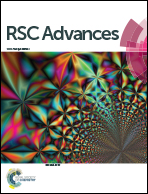The template-free synthesis of hierarchically porous anatase TiO2via acid-etching for enhancing the cycling stability and reversible capacity of lithium ion batteries
Abstract
Although anatase TiO2 demonstrates good performance in many applications, it is very difficult to synthesize nanocrystalline anatase TiO2 with high specific surface areas. Herein, two-dimensional hierarchically porous anatase TiO2 with specific surface area of 486 m2 g−1, is fabricated through acetic acid etching, which facilitates the crystal phase transition of amorphous TiO2. The pore sizes are within the ranges of 2–6 nm and 15–80 nm, and the pore diameters are 3.5 nm and 45 nm. As the anode materials for lithium ion batteries, the initial discharge capacity of hierarchically porous anatase TiO2 reaches to 449 mA h g−1 at a current rate of 0.1 A g−1 and retains 191 mA h g−1 after 60 cycles. In particular, the discharge capacities of 42 and 35 mA h g−1 can be resumed after 750 cycles at the current rates of 1 and 5 A g−1, respectively, exhibiting high electrochemical stability and high reversible capacity. Further research reveals that the fabrication of hierarchically porous anatase TiO2 depends on the amounts of HAc added, and the pH of the solution.


 Please wait while we load your content...
Please wait while we load your content...